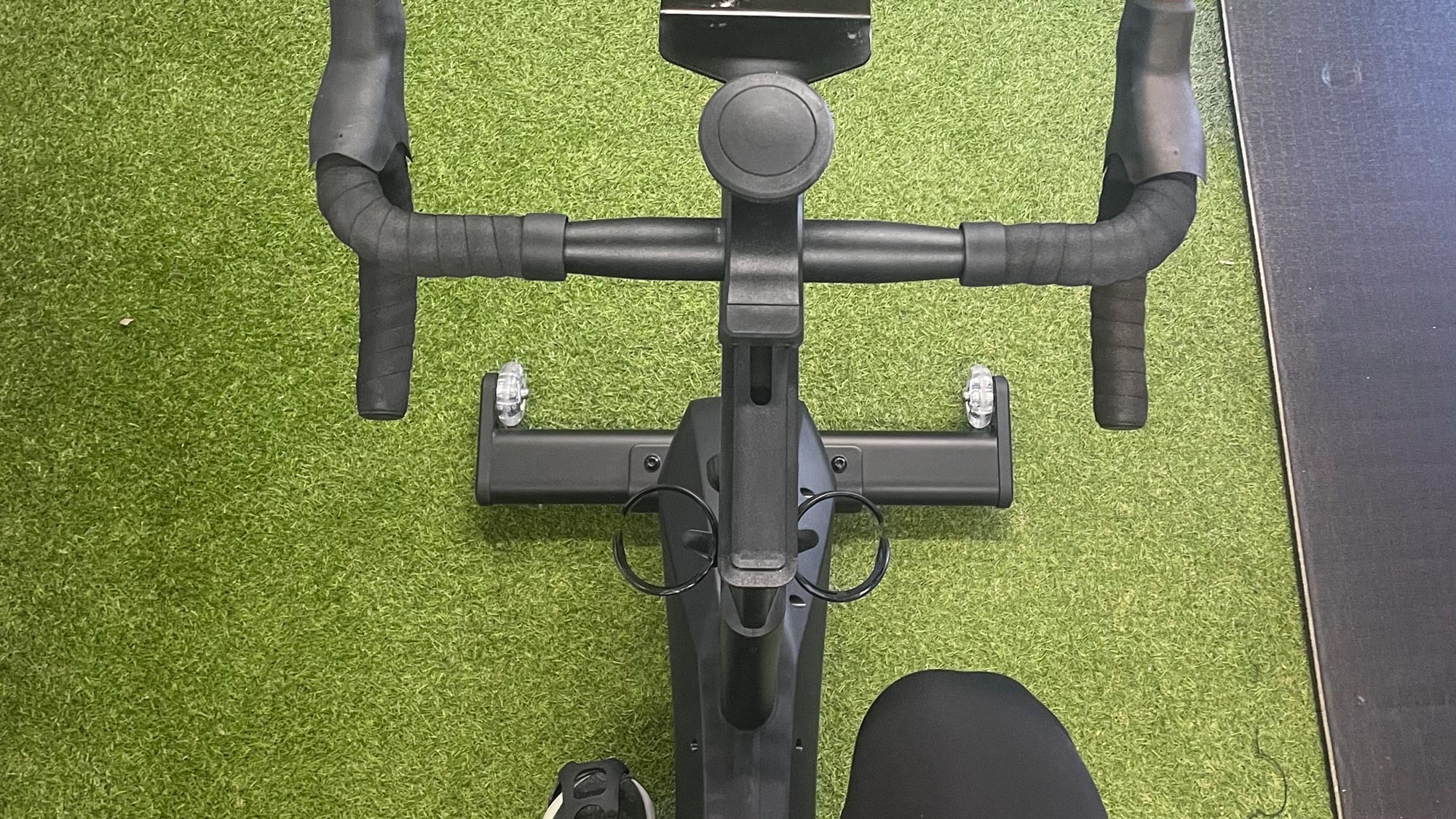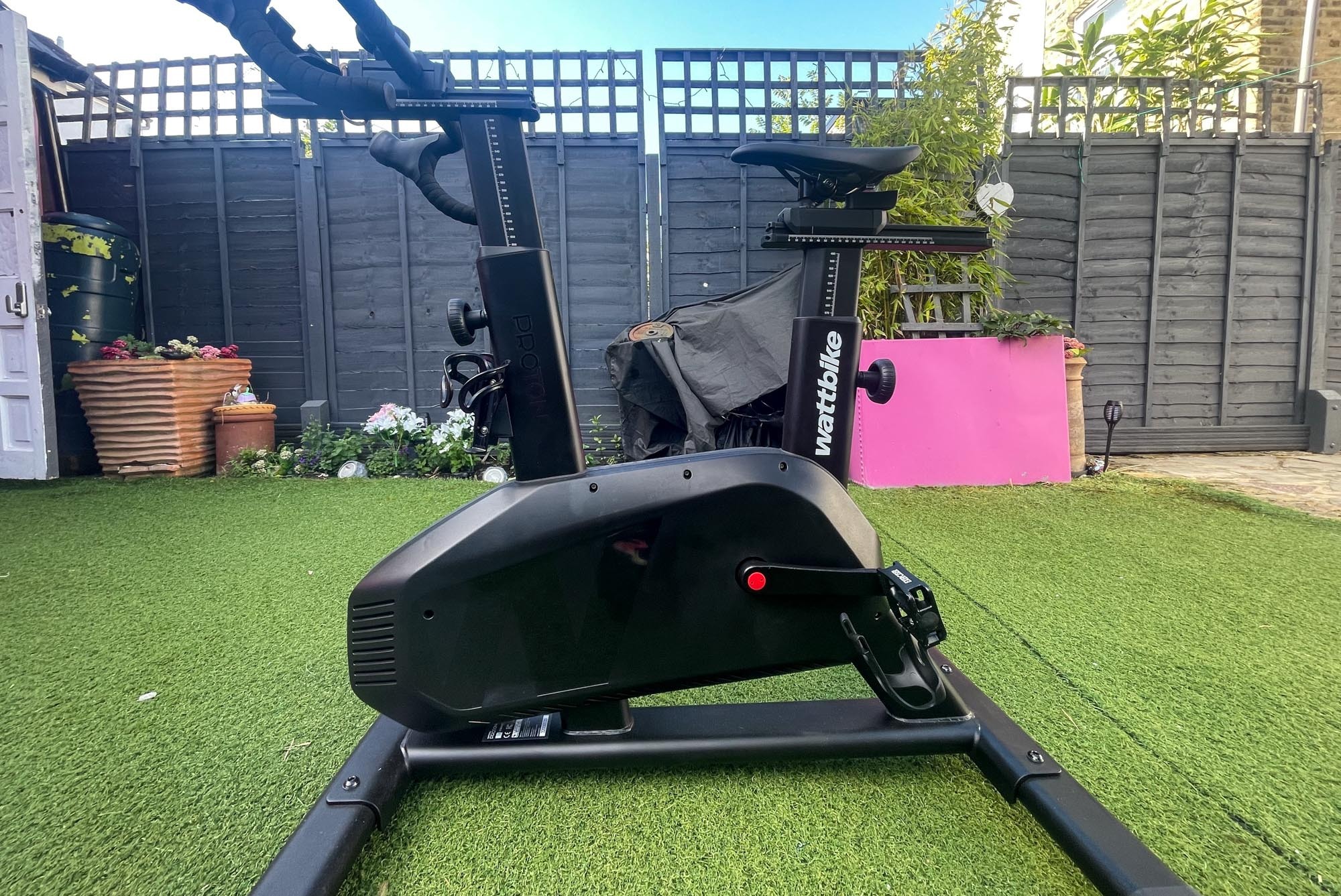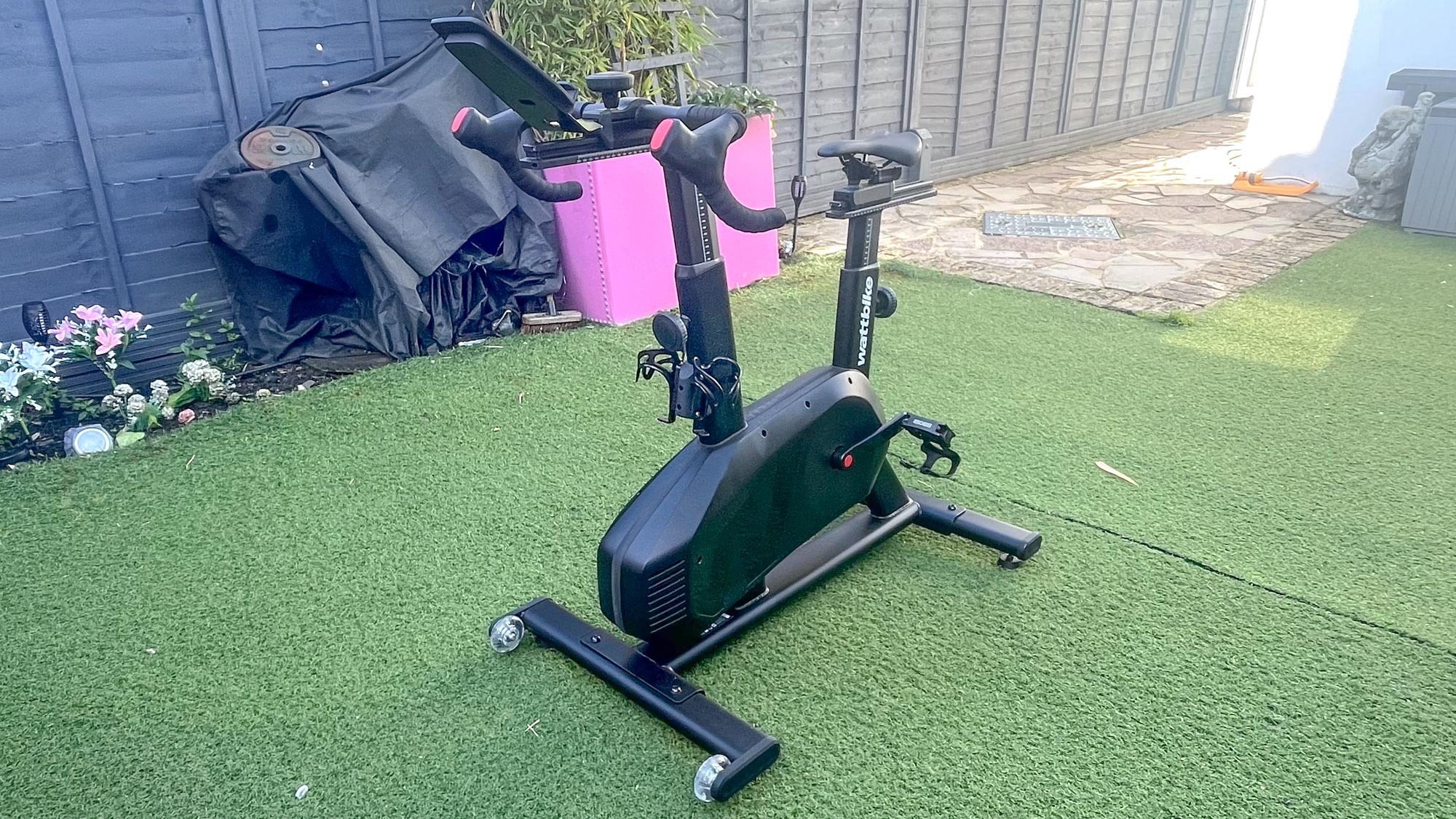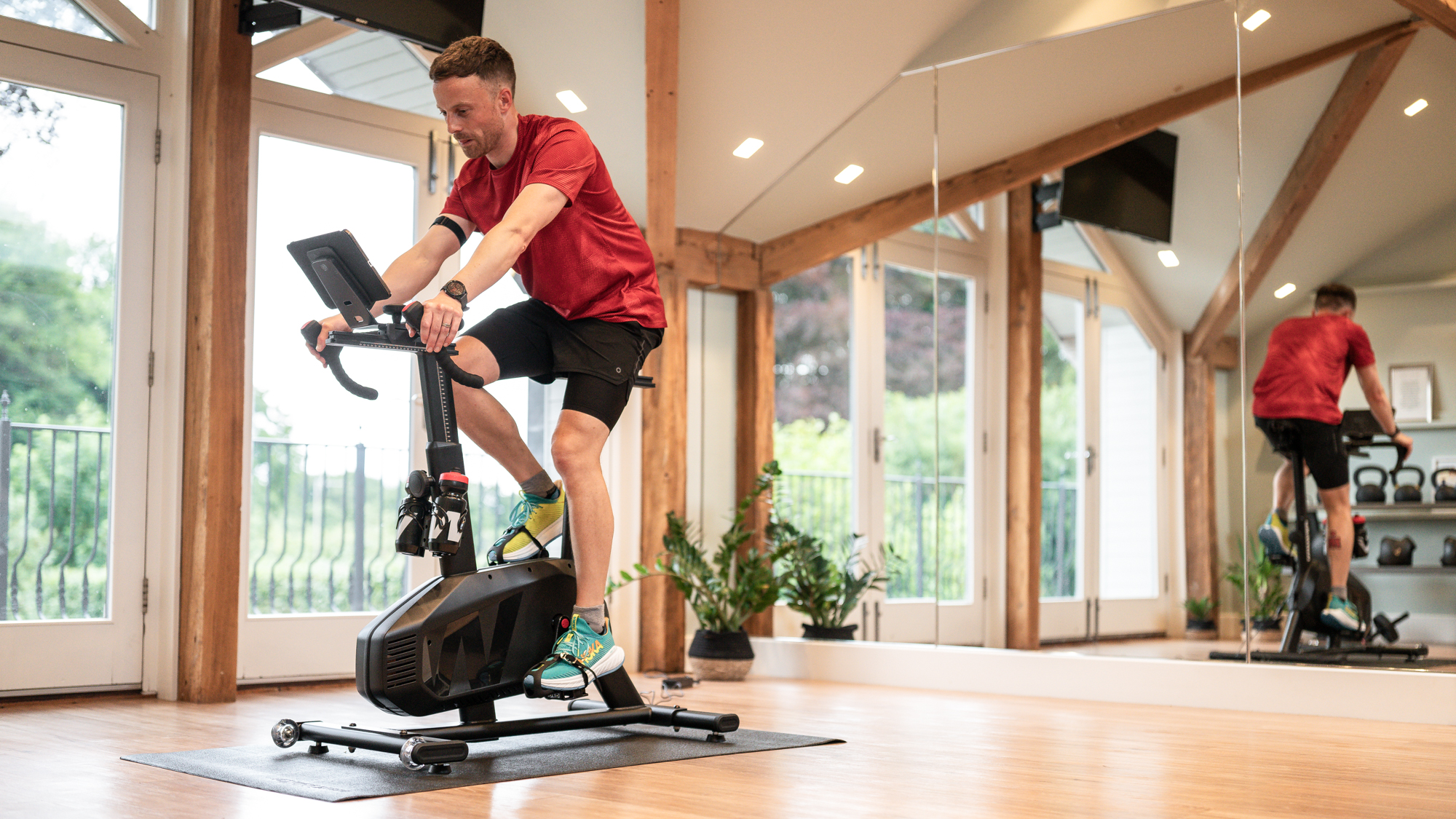Tom's Guide Verdict
The Wattbike Proton is a smart exercise bike designed to be more accessible and affordable than the Wattbike Atom, which is aimed at serious cyclists. It’s easy to set up and use and a serious rival to the Peloton Bike, though there are cheaper options to consider.
Pros
- +
Step-through, adjustable design
- +
Smooth and quiet ride
- +
Connects to apps easily
- +
Wattbike Hub app doesn’t need subscription
Cons
- -
No built-in screen
- -
Cheaper options available
- -
Heavy
Why you can trust Tom's Guide
Height: 38.5-50in
Width: 22.4in
Length: 40.1-49.5in
Weight: 106lbs
Resistance: Electromagnetic
Gears: 22
Power range: 0-1800w
Cranks: 170mm
Rider size: 6’6” to 6’6”
Max rider weight: 298lbs
Connectivity: ANT+ FE-C/Bluetooth FTMS
Wattbike makes some of the best exercise bikes available, but up until now it has focused on keen cyclists with models like the Wattbike Atom. The Wattbike Proton is designed to be a more accessible bike for anyone looking to get fit at home whether they’re a cyclist or not, with a step-through design and a lower price than the Atom.
It’s still an expensive bike, but you don’t have any ongoing costs with the Wattbike Proton, because the Wattbike Hub app can be used subscription free. It does also connect with any other app easily, opening up a world of workouts and virtual cycling apps like Zwift. It’s one of the best options for indoor cycling whatever your health and fitness aims are as a result.
In my Wattbike Proton review I’ll compare the bike to other smart bikes I’ve tested like the Peloton Bike, Zwift Ride and Wattbike Atom, to see if it’s a useful option for your home use.
Wattbike Proton review: Price and availability

The Wattbike Proton launched in the UK in September 2024 and costs £1,795. It is due to launch in the USA and Australia in early 2025, and will cost $2,499 in the US. Wattbike also launched a new air resistance bike called the Wattbike Air at the same time, which costs £1,855 and designed for high-intensity interval training in particular.
The Proton is £400/$500 cheaper than the Wattbike Atom, and cheaper than most smart bikes in general. The Zwift Ride and Peloton Bike are both more affordable, but are tied to use with certain apps that require an ongoing subscription, especially the Peloton.
Wattbike Proton review: design and setup

The Wattbike Proton comes almost fully assembled, you just need to put on the pedals, handlebars and stabilizer legs and adjust the fit to your preferences. It’s easy to adjust the handlebars and saddle using the dials quickly without a tool — I tinkered with the setup several times in my first ride to make it comfortable — and the range of positions available accommodates a wide range of users.
Unlike the Wattbike Atom, the Proton has a step-through design without a top bar on the frame which makes it easier to mount the bike without having to swing your leg over the top. The design makes it look more like a bike you’d jump on in the gym for classes and general cardio, rather than the more cycling-specific look of the Atom.
Get instant access to breaking news, the hottest reviews, great deals and helpful tips.
The Proton still delivers the realistic ride feel of all Wattbikes and the power range still goes up to 1800W, which is not as high as the 2500W you can get on the Atom, but more than high enough for most people. It uses electromagnetic resistance which you can control using the buttons on the drop handlebars to shift gears or change the power target when in ergo mode.
There is no built-in screen on the Proton, which instead has a tablet/phone holder built into the handlebars so you can use a variety of apps with it. There are two bottle holders at the base of the handlebar stem. The pedals that come with the bike have toe cages on them, but you can swap them out for other pedals.
Wattbike Proton review: Wattbike Hub app

One of the main selling points with Wattbikes in general is that you get access to the workouts and training plans in the Wattbike Hub app without a subscription. There is a subscription version of the app, which unlocks a workout builder as the main extra, but it’s not needed to enjoy the bike, unlike with other smart bikes that are tied to a subscription with an app.
Lots of the workouts and training plans are targeted at cyclists preparing for events like 100-mile sportives, but there are also plans aimed at improving your fitness in general, and workouts and plans targeted at helping you perform in other sports. I’m a keen runner and used the indoor cycling workouts for runners in the app during my testing, which involve more out of the saddle work to be more applicable to running.
The app also shows you the advanced insights into your pedaling technique during rides that are a signature Wattbike feature and can be invaluable to keen cyclists trying to improve. Even as someone not focused on improving my outdoor riding I did try to pedal in a more efficient manner using this feature. The main dashboard you see during rides also shows details on the intervals during workouts, plus your power and cadence stats.
Even as a more accessible bike, you still need to get your head around some cycling terminology with the Wattbike, and the workouts in the app are based on your FTP – functional threshold power.
This is a measure of your cycling fitness and intervals are calculated as a percentage of your FTP, which you can measure using tests in the app, similar to how you can measure your FTP with a Peloton, or add to your profile directly. Or you can dive into workouts just using a rough estimate of FTP, which I found didn’t diminish my enjoyment of them.
One thing you don’t get with Wattbike is instructor-led classes like Peloton’s, and the workouts in the app, while effective, aren’t quite as engaging if you’re looking for motivation to push through. The app is more targeted at keen athletes who aren’t looking for a boost to train, but guidance on how to do so effectively. You can pair the Proton with other apps easily though, if you did want a different kind of guided workout.
Wattbike Proton review: performance

I used the Wattbike Proton for a series of 30-60 minute rides during my testing, trying out a couple of the cycling workouts for runners in the app as well as doing another workout and some quick rides with no set targets.
The bike runs quietly and the changes in gear and resistance are smooth. I linked it up to the Zwift app for one ride and the changes in gradient in the virtual cycling app adjusted the resistance on the Proton seamlessly.
On one occasion I had to move the bike to another spot in my house to ride it and it is a heavy bit of kit. Even with the wheels on the base it’s hard to maneuver it solo, and while that’s the case with most exercise bikes, the Zwift Ride is one that I found easier to move around because the bike frame and turbo trainer it attaches to can be moved separately.
The weight does give a solid feel to the Wattbike Proton though and it didn’t move around for me even when I was up out of the saddle and riding hard. Adjusting the saddle and handlebars for other users is also quick and easy and you can use the measurements on the bike to remember the settings for each person.
While the lack of a built-in screen doesn’t really limit the functionality of the Proton because most people have a tablet they can use on the holder, or even a phone, using these small screens instead of the vast HD displays I’ve enjoyed on bikes like the Peloton Bike and Technogym Bike is not quite as immersive during workouts.
Wattbike Proton review: integrations
A key feature of the Proton is that you can link it up with any app you want using the Bluetooth and ANT+ connectivity. Most of those apps will require some kind of subscription, which the Wattbike Hub doesn’t, but you can get a different experience by cycling in the virtual worlds of Zwift or Rouvy, or following workouts in TrainerRoad. You can even use it with the Peloton app, though I’d say the best Peloton experience is had using the Peloton Bike+ and its huge built-in screen.
Should you buy the Wattbike Proton?

The Wattbike Proton is an excellent exercise bike and if you want flexibility in your indoor cycling, it’s the an incredible value smart bike. The Zwift Ride is cheaper and I loved using it, but ties you into using Zwift (for now, at least), so if you don’t plan to stick to that app then the Proton is a better option.
You will get a more immersive experience using a Peloton with its big screen, but you are tied to the Peloton app and the $44 a month subscription you need for it. If you’re all in on instructor-led spinning workouts, then the Peloton Bike+ remains the better option, but you can still follow workouts like that through a tablet with the Wattbike Proton.
If you live in a house where a few different people might use the bike with different apps, the Proton stands out from the competition because of its wide array of integrations, and the hardware is also top-notch, delivering a smooth and solid ride and easy saddle and handlebar adjustments.
Only very keen cyclists, and those who race online in apps like Zwift, will feel the need to upgrade to the Wattbike Atom, in my opinion. The Proton offers a realistic ride feel and will help you train for outdoor cycling if that is your preferred sport, but also feels more approachable to non-cyclists.
If you have a bike at home then a cheaper option would be to buy one of the best indoor cycling trainers like the Wahoo KICKR CORE and use that to pair to apps, but the convenience and extra adjustability of having a smart bike is a notable benefit and I prefer using the Wattbike Proton to the bike and turbo trainer setup I have.

Nick Harris-Fry is an experienced health and fitness journalist, writing professionally since 2012. He spent nine years working on the Coach magazine and website before moving to the fitness team at Tom’s Guide in 2024. Nick is a keen runner and also the founder of YouTube channel The Run Testers, which specialises in reviewing running shoes, watches, headphones and other gear.
Nick ran his first marathon in 2016 and became obsessed with the sport. He now has PBs of 2hr 25min for the marathon and 15min 30sec for 5K. Nick is also a qualified Run Leader in the UK.
Nick is an established expert in the fitness area and along with writing for many publications, including Live Science, Expert Reviews, Wareable, Coach and Get Sweat Go, he has been quoted on The Guardian and The Independent.

